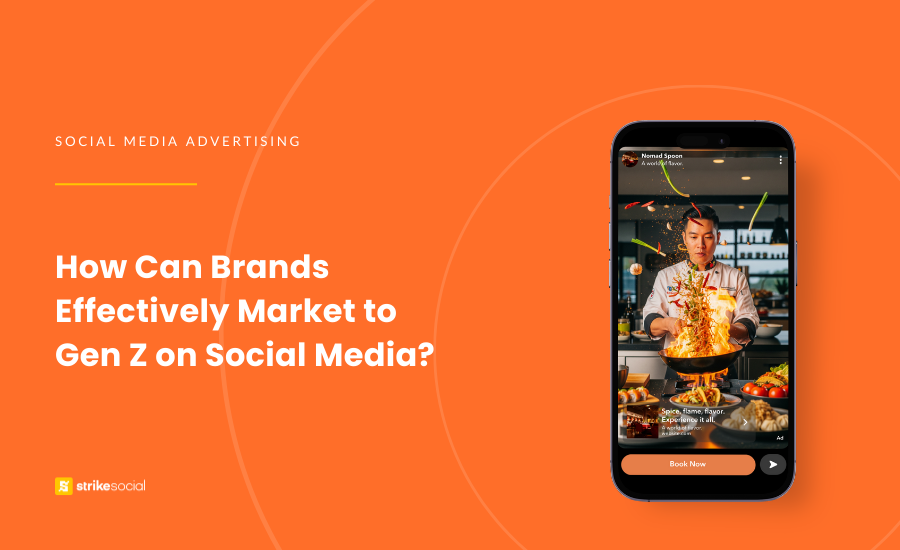Strike Overview
- Marketing to Gen Z is more accessible than ever with their heavy use of social media. 81% spend at least an hour a day on platforms, and nearly half exceed three hours daily.
- The Gen Z age range spans from 13 to 28, which introduces challenges for advertisers, especially when targeting younger users who are subject to stricter ad and privacy regulations.
- Still, understanding how Gen Z engages on social media is a key opportunity. Know the effective strategies for reaching them through compliant targeting, creator partnerships, and platform-specific approaches.
Jump to Section
How Can Brands Effectively Market to Gen Z on Social Media?
Generation Z has set the tone for online culture, brand engagement, and the future of marketing itself. As true ‘digital natives’, Gen Z is the first age group to grow up entirely in the era of smartphones, social platforms, and constant connectivity.
With Gen Z now making up 27% of the global workforce, and even more already influencing household purchase decisions, marketing to Gen Z is no longer optional for brands that want to stay relevant. Performance-driven brands must understand the behaviors, values, and media habits that define the Gen Z demographic to drive long-term growth across social platforms.
Understanding the Generation Z Market
To build effective Gen Z marketing strategies, brands must first recognize how different this generation is from others. What resonates with Millennials may fall flat with Gen Z. Marketing to Gen Z requires more than recycled tactics; it demands a deep understanding of their digital behaviors.
What Is the Gen Z Age Range?
Generation Z typically includes individuals born between 1997 and 2012, placing the Gen Z age range between 13 and 28 as of 2025.
This wide age range introduces a unique challenge for advertisers: targeting an audience that includes minors as well as working professionals.
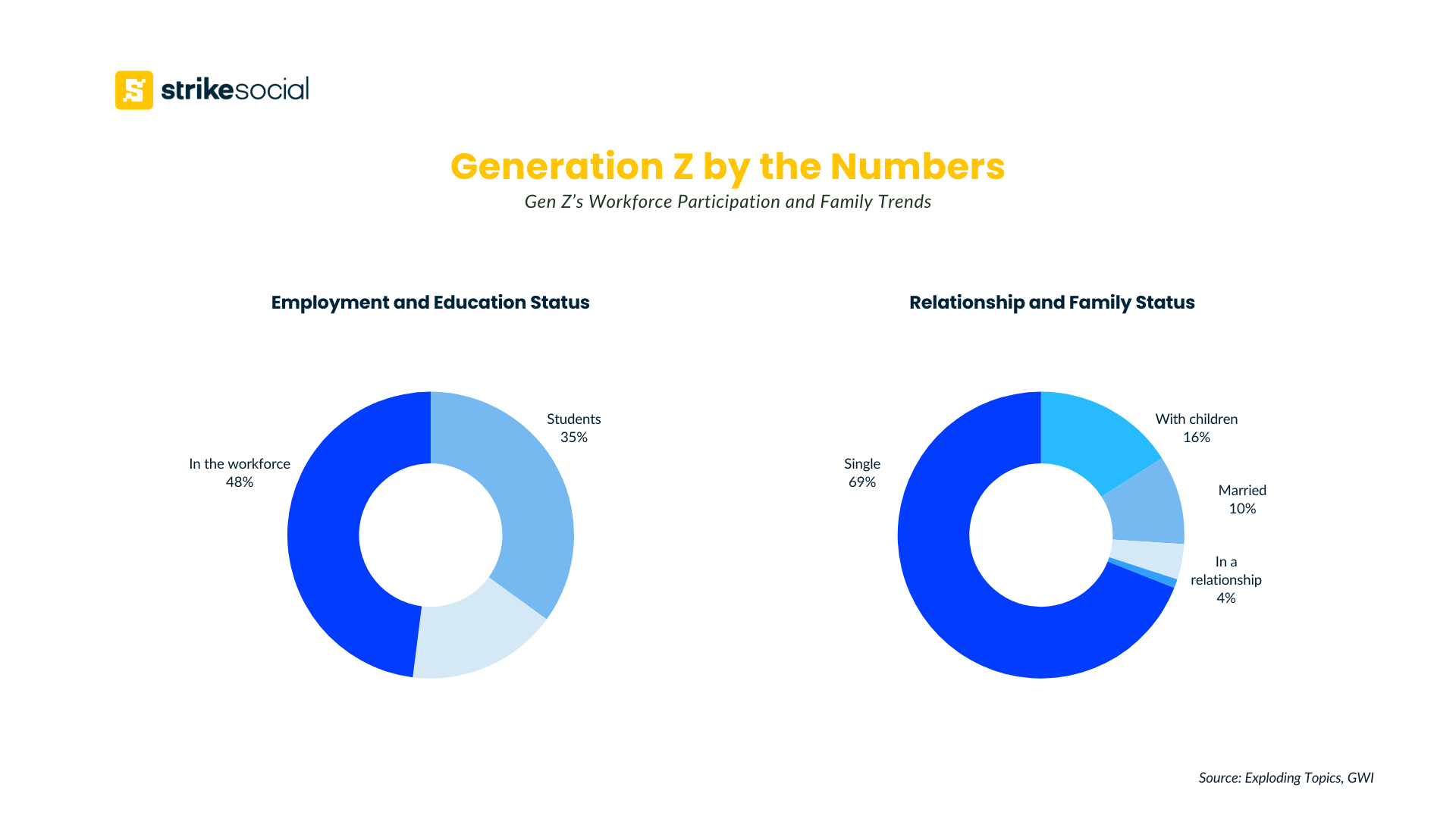
Some members of Gen Z are already entering the workforce and starting families, with workforce transformation consulting firms actively guiding them toward long-term career opportunities. Meanwhile, the younger half of this generation, those still in school with limited purchasing power, also holds significant influence, especially in digital spaces.
Advertising to Gen Z can be both nuanced and rewarding for brands willing to tailor their approach based on the generation’s diverse stages of life and digital expectations.
Marketing to Gen Z vs Millennials
When marketing to Gen Z vs Millennials, it’s important to recognize where these two generations overlap and differ. While they’re often grouped together in digital strategies, each age group has distinct preferences, behaviors, and expectations that affect how they engage with brands.
Purchase Behavior
Gen Zers are becoming increasingly aware of personal finance, with interest in this topic rising four points from 2018 to 2024. However, despite this growing financial literacy, 41% of Generation Z still identify as impulse buyers, suggesting they respond well to bottom-funnel strategies like limited-time offers and high-impact direct response ads.
On the other hand, millennials follow closely behind in impulse purchases at 34% but require more nurturing through the funnel. Research shows that 60% of millennials only purchase when convinced of the product’s value, making top and mid-funnel messaging essential for conversion.
Social Media Usage
While data for users under 18 is often restricted due to privacy policies, we can compare Gen Z and Millennials’ platform usage among those 18 and older:
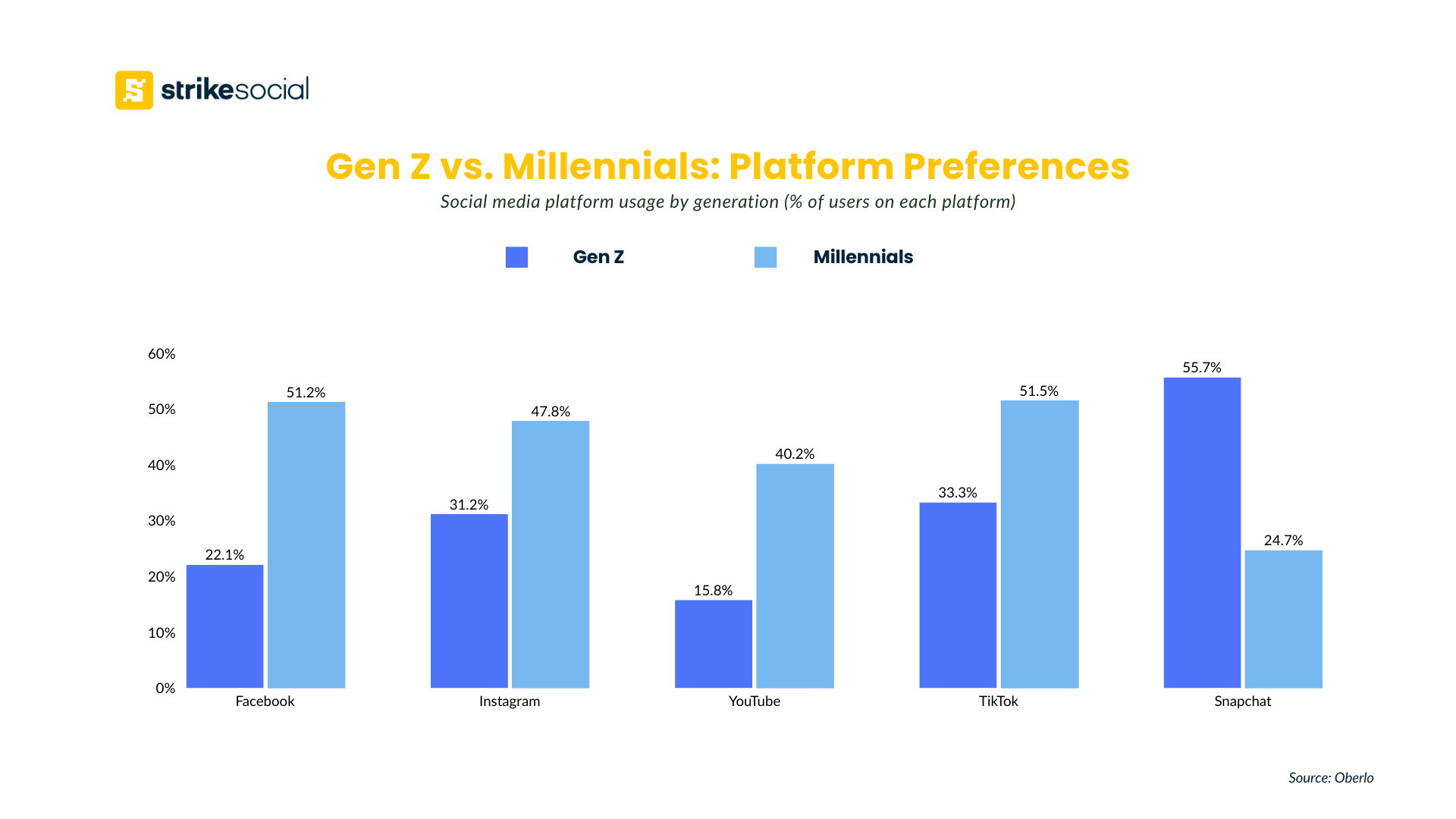
Snapchat stands out for its strong hold on younger audiences, reaching 90% of the Gen Z demographic, including users aged 13–17. Despite the high percentage of minors on the platform, Snapchat estimates the buying power of Gen Zers on its platform to be $44 billion. Its interactive and creator-first design makes it highly effective for Gen Z advertising.
In contrast, platforms like Facebook, Instagram, and YouTube see heavier millennial usage. TikTok remains competitive across both groups but edges out slightly among millennials in volume, likely due to wider age inclusivity in reported data. Still, TikTok’s short-form, creator-driven model aligns closely with Gen Z marketing strategies.
Content Consumption
Both generations rely on social media to stay informed: 77% of Gen Z and 67% of millennials use social platforms to keep up with current events.
What sets Gen Z apart is how they consume brand content through creators and influencers. Influencer marketing holds strong across both demographics: 70% of millennials in the U.S. follow at least one influencer. As for Gen Z, influencer-led discovery often drives purchase intent and brand recall more directly.
By getting to know the Generation Z demographic better, brands can fine-tune campaigns that speak more directly to each generation’s mindset and behavior.
Further Reading
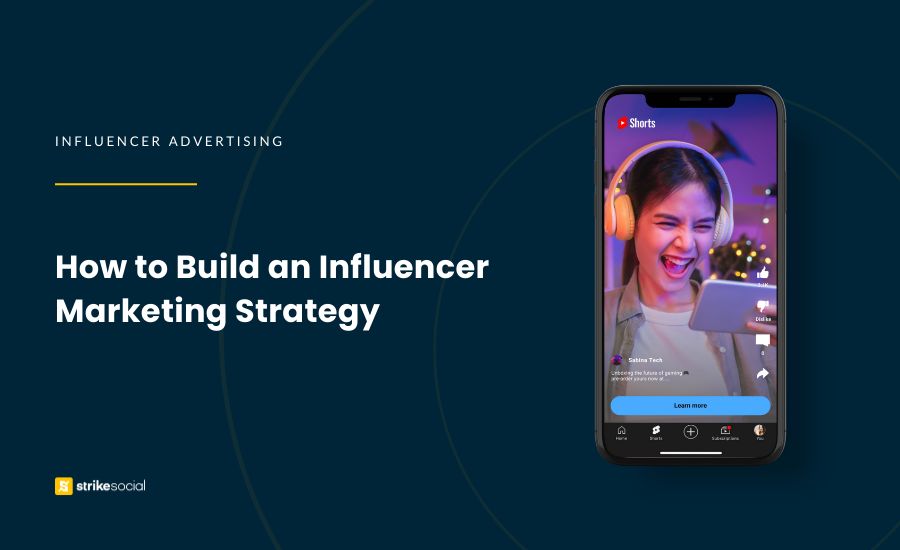
Developing an Influencer Marketing Strategy
Incorporating influencer content into your paid social ads helps build a community of audiences who already trust the faces representing your brand. By partnering with creators whose followers align with your target market, you expand your reach authentically and effectively. Learn how to launch an influencer strategy that not only starts strong but lasts.
Marketing to Gen Z on Social Media
Generation Z is the most digitally connected generation, and social media is where they discover, engage, and reach brands. If you want to succeed in marketing to Gen Z, you need to meet them on their platforms, and on their terms. That means understanding not only where they spend their time, but also how they use each platform differently.
How Do Gen Z Use Social Media?
To effectively market to Gen Z, brands must start with platform selection. Knowing where your Gen Z audience is most active helps you prioritize your media buying and content strategy. And for this generation, short-form, visual-first content is king.
According to Sprout Social, here’s how many Gen Z users say they use at least one account on each major platform:
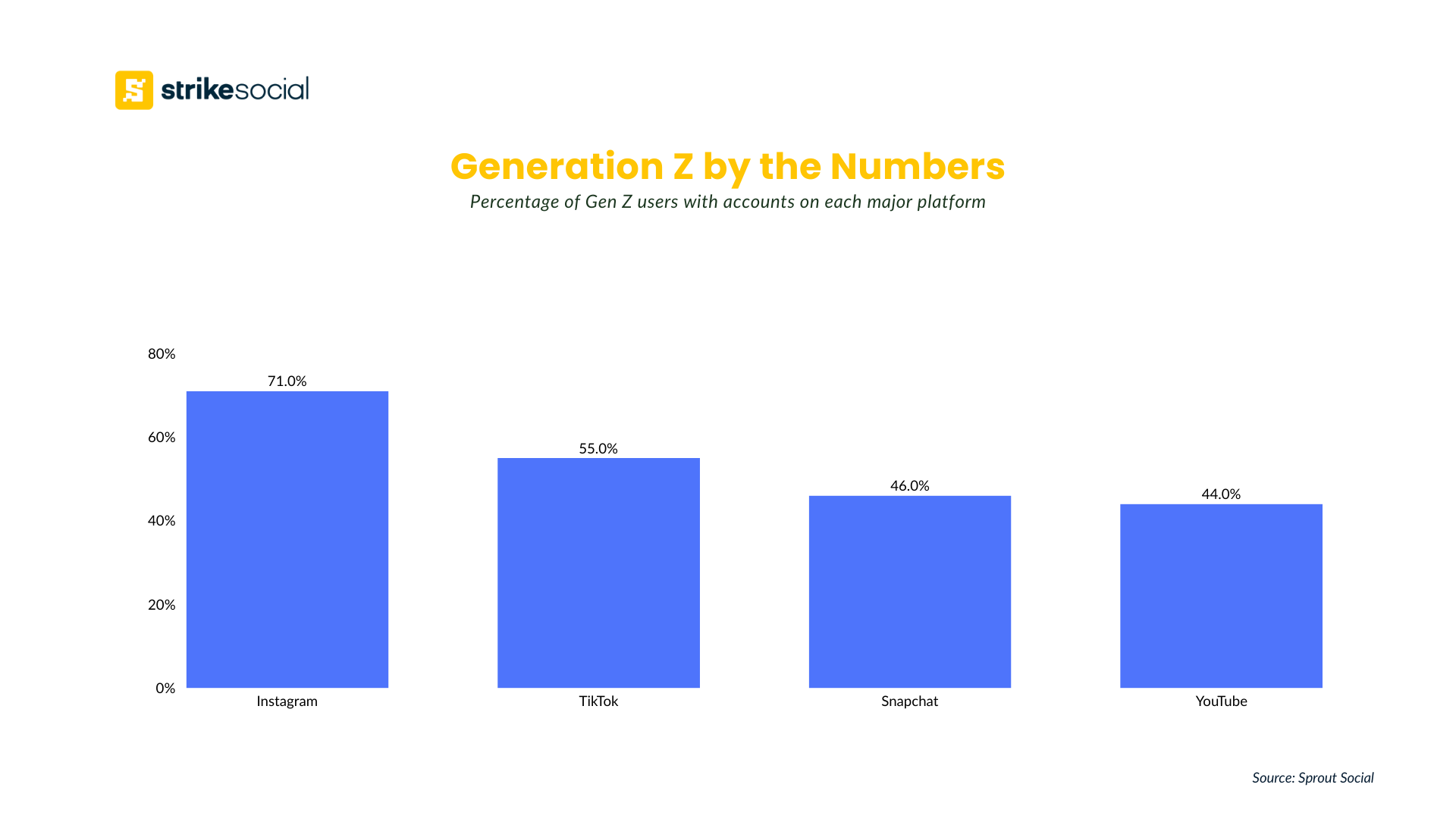
Why Is Social Media Marketing the Most Effective Channel for Gen Z?
It’s no secret that social media is at the frontline when it comes to marketing to Gen Z. This generation isn’t passively scrolling; they’re engaging and buying directly on their favorite platforms. Here’s why social media remains the most powerful channel for Generation Z marketing strategies:
Social-First Shopping Behavior
Gen Z uses social media platforms as primary discovery engines for new products and brands. But discovery is just the beginning. Gen Zers are highly intentional with their purchase behavior:
After discovering a brand or product, they take several additional steps before deciding: 75% read the comments, 74% visit the brand’s website, and 72% check reviews.
Influence of Content Creators
When it comes to advertising to Gen Z, influencer marketing plays a pivotal role, with macro-influencers (100K to 1M followers), who have proven to drive high engagement within this demographic.
More importantly, co-created content (brand and influencer collaborations) outperforms standalone influencer ads. Platforms like Instagram make this seamless through Partnership Ads, which feel more authentic and aligned with Gen Z preferences. These collaborations give your brand credibility and increase the chances of recall and conversion.
Social Platforms as Search and News Engines
Forget traditional search. Today’s Gen Z age group is turning to social platforms first for news discovery and staying informed.
In fact, Google has dropped to third place as the go-to search tool for Gen Z. Brands that position themselves as informative, relevant, and trend-savvy can surely win Gen Z’s loyalty on these platforms.
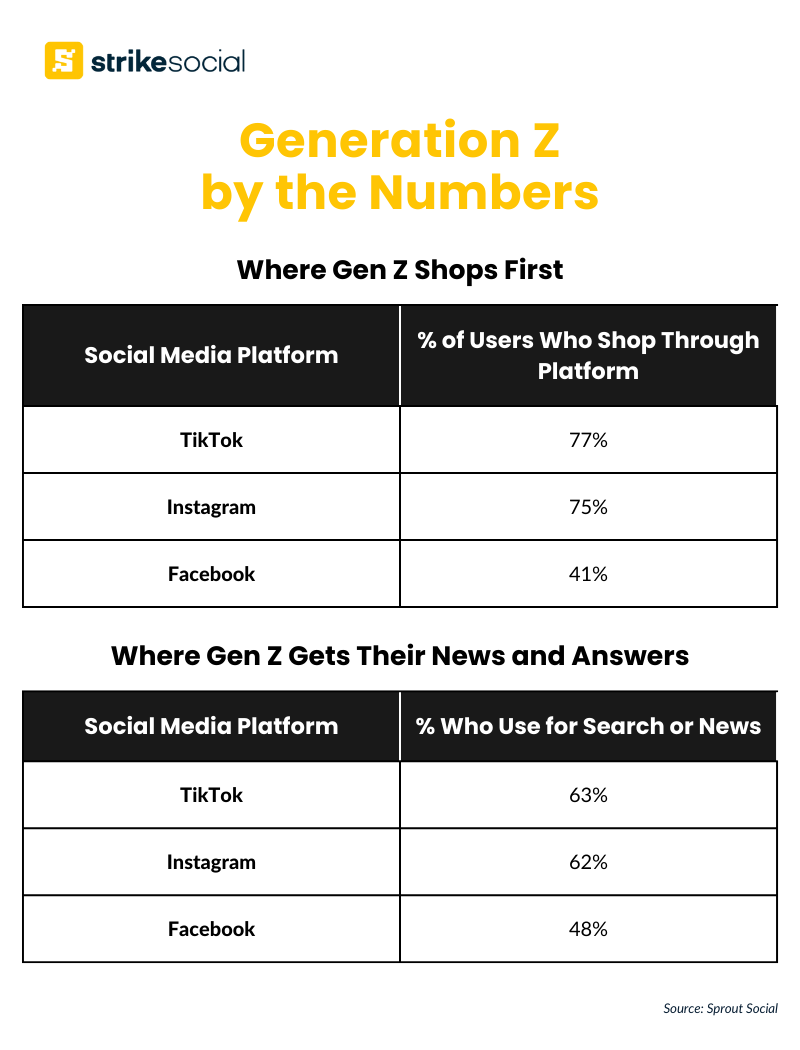
To market to Gen Z effectively, brands must go beyond ads and adopt a social-first strategy that blends creator partnerships, trend-driven content, and community-driven discovery. Social media is not just a channel for Gen Z: it’s where they discover, evaluate, and buy, making it the most powerful touchpoint for this generation.
Advertising to Gen Z in Paid Social
Now that you know where and how Gen Z engages on social media, the next step is crafting a paid advertising strategy tailored to their age group and platform behavior. However, marketing to Gen Z, especially younger teens, comes with unique limitations that you must account for in your campaign planning.
Limitations with Advertising to Gen Z Audiences
All major platforms heavily regulate advertising to users under 18 due to global privacy laws and platform-specific policies. These restrictions impact how you can target and what content you can show to Gen Z, especially those between the ages of 13 and 17.
For example, in regions like the EU, EEA, and Switzerland, ads typically cannot be shown to users under 18 at all. In other markets, ad targeting for this group is often limited to broad demographic categories, with no access to personalized targeting.
Gen Z users aged 18–24, however, are fully eligible for personalized ad targeting, making them a key segment for performance-driven campaigns.
| Gen Z Audience Targeting Restrictions in Meta (Facebook and Instagram) |
|---|
| Unavailable Targeting Options |
| Gender |
| ZIP code or custom location radius |
| Detailed targeting (interests, behaviors, and demographics) |
| Language |
| Custom audiences |
| Lookalike audiences |
| Advantage+ app campaign objective |
| Available Targeting Options |
| App install campaign objective |
| Reach/impressions campaign objective |
| Link clicks campaign objective |
| Offsite conversions campaign objective |
| More profile visits goal (Instagram only) |
| Conversion Lift tests |
| Detailed targeting (interests, behaviors, and demographics) |
| Source: Meta Business Help Center |
| Restricted Google & YouTube Ad Categories for Users Under 18 |
|---|
| Adult & sexually suggestive content |
| Adult media |
| Alcohol, tobacco, & recreational drugs |
| Body modification and weight loss products |
| Contests, sweepstakes, & lotteries |
| Dangerous or harmful content |
| Dating & relationship services |
| Gambling, betting & casino games |
| Pharmaceuticals and supplements |
| Shocking content |
| Speculative financial products |
| Surveillance tools and arrest record services |
| Virtual worlds & adult-oriented chatrooms |
| Source: Google Advertising Policies |
Because of stricter restrictions on Facebook and Google, TikTok and Snapchat have become go-to platforms for reaching Gen Z teens aged 13–17. They still have limitations, but offer more advertising flexibility for younger age groups.
| Gen Z Audience Targeting Restrictions in TikTok |
|---|
| Unavailable Targeting Options |
| Gender |
| Spending power |
| Household income |
| Audience |
| Interests & behaviors |
| Available Targeting Options |
| Age |
| Language |
| Location (except zipcode) |
| Device |
| Search keywords (only for USA) |
| Lead Generation campaign objective |
| Sales campaign objective (TikTok Shop) |
| Source: TikTok Business Help Center |
Snapchat actively promotes its platform as suitable for ages 13 and up. The app offers more flexibility in targeting younger Gen Z audiences, though it is still highly dependent on country-specific regulations and content categories.
Here’s how Snapchat manages age-based restrictions across different regions:
| Ad Minimum Age Requirements and Restrictions By Country | ||||||
| Country | Alcohol | Gambling & Lotteries | Financial Products & Services | Contraceptives | Over-the-counter Medicine | Online Dating Services |
| Australia | 18+ | 18+ | Dependent on the products or services promoted | 18+ | No minimum age required | 18+ |
| Brazil | 18+ | 18+ | Dependent on the products or services promoted | No minimum age required | No minimum age required | 18+ |
| Canada | 19+ | 19+ | Dependent on the products or services promoted | No minimum age required | No minimum age required | 18+ |
| Saudi Arabia | Not permitted | Not permitted | 18+ | No minimum age required | No minimum age required | Not permitted |
| United Arab Emirates | Not permitted | Not permitted | 18+ | No minimum age required | No minimum age required | Not permitted |
| United Kingdom | 18+ | 18+ | Dependent on the products or services promoted | No minimum age required | 18+ | 18+ |
| United States | 21+ | 18+ | Dependent on the products or services promoted | No minimum age required | No minimum age required | 18+ |
Workarounds & Strategy
Despite strict limitations on targeting Gen Zs, effective strategies still exist to reach this influential audience. Gen Z represents a major share of social media activity, and while direct targeting is restricted, there are smart workarounds to get your brand noticed and drive meaningful engagement.
Broad Targeting
TikTok’s user base includes a large share of teens, with approximately 25% of all users 20. Thus, even with restrictions, brands can still reach younger Gen Z users using broad targeting. This includes options like location, language, device type, and search keywords (U.S. only).
Snapchat offers even more flexibility. Although general ad targeting is often set to 18+, platforms like Snapchat allow you to refine by:
- Placement
- Age
- Language
- Location
- Device details (OS, carrier, phone model)
Creator and Influencer Collaborations
Influencer marketing continues to be one of the most effective ways to reach Gen Z. Partnering with creator marketers for branded content, sponsored posts, or hashtag challenges allows you to circumvent ad targeting limitations while still resonating with Gen Z’s values. These collaborations feel more authentic and peer-led and are more likely to earn Gen Z’s trust and attention.
At the same time, brands are increasingly using AI agents in campaign planning and engagement optimization, making it highly critical to preserve authenticity. For Gen Z, genuine voices and relatable storytelling remain the foundation of meaningful connections.
Case Study:
To reach Gen Z shoppers, a skincare brand partnered with Strike Social to run a TikTok traffic campaign. Despite audience targeting challenges, our team leveraged detailed targeting strategies and placements to connect with the brand’s ideal Gen Z audience.
Using creator-led content, the campaign achieved up to 96% video completion rates. Strategic ad placement ensured the content appeared in formats and spaces where Gen Z is most active. Through continuous testing and optimization, the campaign proved that smart planning and authentic content are key to Gen Z success.
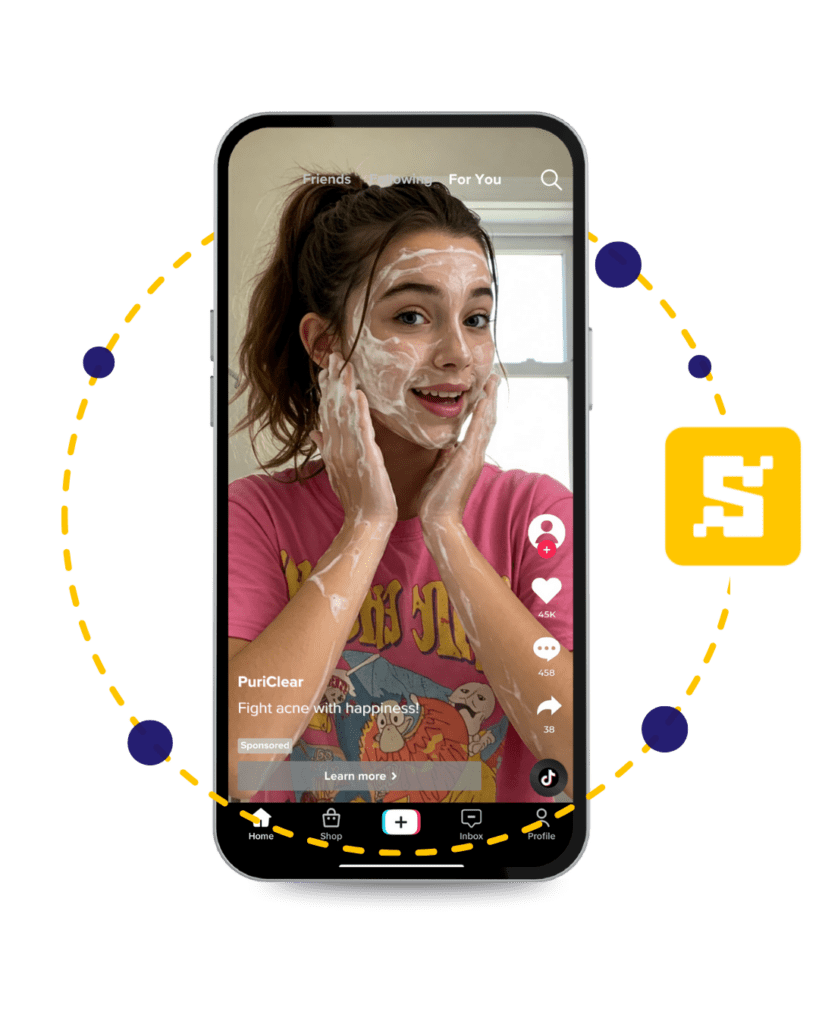
Using Effective Ad Formats on Meta and YouTube
Even though Facebook and YouTube advertising restrict targeting for users under 18, Gen Z adults (18–24) remain fully targetable. These platforms still offer effective ways to reach Gen Z through high-performing ad placements.
Here’s a quick look at top-performing Meta placements for click-focused campaigns:
| Ad Placement | CTR |
|---|---|
| Facebook Feed | 2.07% |
| Facebook Stories | 1.80% |
| Facebook Instream Video | 1.67% |
| Instagram Stories | 0.74% |
| Overlay ads on Facebook Reels | 0.43% |
On YouTube, Shorts are especially effective with Gen Z, offering up to 15.9% engagement rates when paired with influencer content. These short-form videos align with Gen Z’s media habits and offer a prime format for brand engagement.
Successfully advertising to Gen Z requires more than just checking the right targeting boxes: it demands an adaptive strategy, constant optimization, and content that speaks their language. For in-house teams, this can be a resource-heavy lift.
Partnering with an expert ad agency can help you gain an advantage over competitors in effectively marketing to Generation Z. Request a personalized walkthrough from our team and learn how marketing to Gen Z audiences can be made easier.
Turning Gen Z Attention into Brand Loyalty
You may think marketing to Gen Z simply means following the latest trends, but it’s also about understanding a generation that values authenticity, creativity, and community. While they may be digital natives, Gen Z is also highly selective about the brands they engage with, making trust and genuine connection more important than ever.
Their behavior online is shaped by a deep awareness of digital culture and a clear expectation for transparency. Brands that embrace this mindset by delivering real value, relatable content, and inclusive messaging are more likely to earn recognition and recall from Gen Z audiences.
As social platforms evolve, so will Gen Z’s expectations. Capturing their attention is just the beginning: building trust and growing with them is how you turn that attention into lasting brand loyalty.
Article by
Lee Baler, Strike Social’s VP of Sales & Strategy
Lee leads global strategy, helping clients and agencies maximize YouTube and paid social performance. Constantly tracking industry trends, he translates insights into strategies that help brands stay competitive and achieve sustained profitability.


